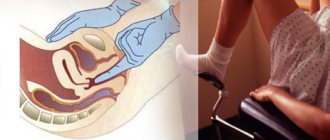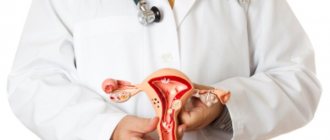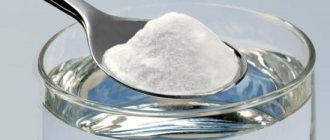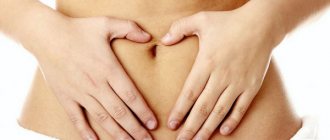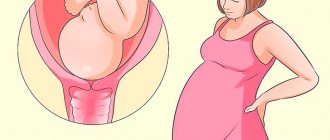Uterine prolapse or prolapse is a fairly common gynecological pathology, the treatment of which depends entirely on the degree of development of the disease.
This diagnosis is more often encountered by older women who have already given birth, but, unfortunately, in recent years the disease has become significantly “younger”.
There are many reasons for the development of prolapse: excess weight, inguinal hernias, gastrointestinal disorders (frequent constipation), as well as difficult childbirth, accompanied by injuries of various types.
One of the ways to treat uterine prolapse is massage. We will talk about its types in this article.
The essence of pathology
Uterine prolapse (med.) is a pathological position of the reproductive organ, in which both the uterus and the cervix are displaced significantly below the anatomical and physiological boundary due to weakening of the ligaments and groups of some muscles of the pelvic floor.
Prolapse is often accompanied by displacement of the vagina and manifests itself in the form of quite unpleasant and painful sensations in the lower abdomen, especially in the vaginal area.
The pathology disrupts the functioning of the pelvic organs - difficulties appear with urination, bowel movements, and a complication of the disease is partial, or less often complete loss of the organ.
Does sex make prolapse worse?
The pathological process in most cases can intensify with active sex.
The stages of development of the pathology only increase the swelling of the reproductive organ and “squeeze” the vagina, as a result of which the woman begins to experience quite painful sensations.
Over time, the pain begins to become so pronounced that sexual contact becomes impossible in principle, since the patient simply cannot tolerate the pain.
That is why gynecologists often advise women to abstain from sexual intercourse, especially during pathology therapy.
Degrees of uterine prolapse
Doctors distinguish several degrees of development of the disease:
- 1st degree - slight, but nevertheless quite painful prolapse of the body and cervix into the vagina, without protrusion from the genital slit;
- 2nd degree – partial loss of the reproductive organ from the genital opening, especially during physical stress (lifting weights, sneezing or coughing);
- 3rd degree – incomplete prolapse of the organ from the genital fissure (part of the body of the uterus and the entire cervix);
- 4th degree - complete exit of the uterine body beyond the genital slit.
The pathology in the initial stage of development is practically asymptomatic, which complicates its diagnosis and treatment.
In later stages, a woman experiences the following symptoms :
- quite painful sensations in the lower abdomen;
- bleeding from the vagina;
- menstrual irregularities;
- dyspareunia (pain during sexual intercourse).
Having sex
So is it possible to have sex with this pathology?
The answer to this question, often asked by women diagnosed with uterine prolapse of varying degrees, can only be given by the attending gynecologist, having studied the characteristics of the patient and the clinical course of the pathology in each specific case.
For some patients, sexual relations do not cause much discomfort, and sexual intercourse itself does not provoke a worsening of the process. But in other cases, sexual life may be completely contraindicated for the patient, especially during the period of treatment of the disease or in advanced stages of the process.
Is massage effective?
At an early stage of the development of the disease, the problem can be effectively solved with the help of special gymnastics (according to Yunusov’s method), physiotherapy courses and, of course, massage. With a competent approach and a combination of all methods, you can count on a fairly favorable prognosis.
Using massage techniques you can achieve:
- effectively improve blood circulation of the reproductive organ;
- increasing the tone and elasticity of the walls of the uterus;
- normalization of the menstrual cycle and the functioning of many systems and pelvic organs.
Only a doctor can diagnose uterine prolapse. Without consulting a specialist, you should not resort to independent treatment methods - this can not only aggravate the problem, but also cause quite serious harm to the entire body.
Massage (gynecological) is prescribed and performed only by an obstetrician-gynecologist only after conducting appropriate examinations of the patient and accurately determining the degree of development of the pathology.
Forecasts
Uterine prolapse may have a favorable prognosis. To do this, you should carry out full treatment and strictly adhere to all medical recommendations. It is very important to avoid overloading the pelvic organs with excessive loads. Every woman should take the utmost care of her health, paying special attention to the organs of the reproductive system.
Uterine prolapse is a fairly serious disease that is accompanied by intense pain. In advanced cases, such severe discomfort occurs that the woman cannot have a full sex life. To avoid dangerous complications, it is very important to consult a specialist in time and strictly follow medical recommendations.
Regular sexual intercourse with a regular partner prevents many gynecological diseases, but intimate life during uterine prolapse should be considered differently. In the initial stages of the disease, the patient does not experience any discomfort. This does not create the need to give up your usual way of life. Over time, you have to say goodbye to your intimate life, as it not only ceases to bring pleasure, but also causes extreme suffering.
Main types of procedure
Prolapse is always accompanied by pain, so for effective treatment, doctors prescribe gynecological massage of the uterus.
In addition to gynecological, for the effective treatment of progressive uterine prolapse, doctors prescribe the use of vibration, vaginal or reflex massage. But each method also has contraindications, so the selection of therapy should only be carried out by an experienced doctor!
Self-massage
The most effective method of “home” massage, known since ancient times and successfully performed by many patients, is with the help of ordinary potatoes.
To do this, you need to lie on a hard surface with your knees bent. Massage the abdomen over the area of the uterus for several minutes (with movements as if lifting the uterus up).
Then you need to cut the potato into 2 halves, stick matches (5 pieces) into one, heads up. Place the vegetable on the stomach in the navel area, light matches and cover with a half-liter jar, greased from the inside with oil.
So you need to lie down for 5-10 minutes, then remove the structure (like removing medical cups - so that air can get under the edges) and lie down for about half an hour with your legs raised up (much higher than your head). Then tighten the belly again with the cloth and slowly stand up.
This massage must be carried out on an empty stomach for three days in a row. Physical activity and heavy lifting are prohibited on these days.
For older women suffering from uterine prolapse, you can perform special Kegel exercises - you need to regularly, about 25-30 times a day, alternately tense and relax the vaginal muscles (as if you need to hold back strong urination).
When the uterus prolapses, a woman will be helped by daily performance of fairly simple, but nevertheless very effective exercises - “birch tree”, “bicycle” or “scissors”. Riding a regular bicycle also normalizes poor blood circulation and strengthens the muscles and ligaments of the pelvic floor.
Gynecological
This procedure must only be performed by a qualified specialist.
The massage is performed on a gynecological chair. Before the procedure, the woman must observe the rules of basic personal hygiene and empty her bowels. It is advisable to carry out this massage on an “empty stomach”.
Before the session begins, the doctor treats the patient’s hands and genital area with a special antiseptic. Then, using palpation, the doctor acts on the area of the uterus (the fingers of the right hand are inserted into the patient’s vagina, and the left hand synchronously presses on the abdominal area from the outside).
After the session you need to lie down for 10-15 minutes.
The main condition for a successful session is complete relaxation of the woman and fairly accurate, competent and careful performance of the procedure by the doctor.
At first, after the sessions, patients may experience discomfort and pain, but after a few sessions everything goes away.
Vacuum
On your own, at home, you can perform the so-called vacuum massage - the oldest known and effective method of treating uterine prolapse.
Let's take a closer look at how it's done.
To do this, you need to take a half-liter glass jar, place it on a hard surface and lie on top so that the navel area is located in the center of the neck of the jar. You need to hold out in this position for several minutes, although the procedure is very painful and unpleasant.
Sexual relations after treatment
Marital relationships in terms of intimacy should be excluded for the duration of treatment. The most effective method for correcting displacement of the pelvic organs is surgery. Surgical intervention is prescribed for patients at stages 3-4 of the pathological process, when intimacy begins to bring them painful sensations in any position. In this situation, there are two options:
- refuse surgery, constantly wear a supporting pessary and exclude intimate life;
- agree to treatment and return to sex after completion of the rehabilitation period.
Most patients of reproductive age agree to surgical treatment. Depending on the correction technique performed, individual recommendations regarding abstinence are given. Usually you have to give up intimate life for 1-3 months. If complications arise during treatment, the period may increase.
After completing the rehabilitation period, some patients experience problems with intimacy. Due to incisions and stitches in the vaginal area, sensitivity is reduced. This phenomenon is considered a temporary complication and usually goes away on its own within the first year after surgery. A decrease in the sensitivity of nerve endings in the vagina is not a reason to refuse sex. Partners can independently find ways to solve this problem by choosing an alternative to traditional sex.
Many men notice that after surgical treatment of prolapse, their partner’s vagina has become narrower. This is due to a special technique for performing the operation, which involves plastic surgery and correction of the shape of the labia. The nuances of treatment measures can be discussed with your doctor individually.
After surgical treatment of uterine prolapse, regular intimacy is recommended. It is important to use contraceptives to avoid unwanted pregnancy, since abortion will not have the best effect on your health. Intimacy after treatment of prolapse is a kind of prevention of relapse. Typically, women after surgery are prescribed electrophoresis and gynecological massage to prevent adhesions and accelerate regeneration processes. Intimacy can completely replace these procedures. It is important that the movements are careful and do not injure the vagina.
Useful video
Video about gynecological massage:
The diagnosis of uterine prolapse is faced mainly by women of mature age who have already undergone childbirth. But not only the birth of a child can cause a problem. Prolapse of the uterus can be caused by excess weight, excessive physical activity, inguinal hernias, and frequent constipation.
At an early stage of the development of the disease, methods such as special gymnastics (according to Yunusov), course herbal medicine and some types of massage will help solve a delicate problem. With a competent combination of all three approaches, you can count on a favorable outcome.
Important: only a doctor can diagnose uterine prolapse. It is not advisable to resort to home remedies without consulting him - this can aggravate the problem and even be dangerous for your overall health. All the recommendations given below are effective at the initial stage of the disease.
Symptoms of prolapse correspond to each stage of the disease. Only a doctor can determine the degree. The most common symptoms of uterine prolapse include aching pain in the lower abdomen, which becomes constant. In the last stage, uterine prolapse occurs. Bowel problems (constipation) and urination (incontinence) are also associated with uterine prolapse. This disease leads to the inability to have sexual intercourse and infertility.
Gymnastics according to Yunusov for uterine prolapse
The first exercise is imitation of urinary retention. Imagine that you really want to go to the toilet “in a small way”, but you have to be patient. What will you do for this? That's right, you will begin to strongly strain the muscles in the perineum area. The advantage of this exercise is that it can be performed anytime and anywhere: standing in transport, sitting in the office, while walking, etc. The same exercises can help with urinary incontinence, which is also present in almost all women after childbirth.
The following exercises are aimed at strengthening weak abdominal muscles. First of all, they are good for preventing uterine prolapse, and indeed for women’s health in general. These are the “birch tree”, “scissors”, “bicycle riding” familiar to everyone from childhood. All of them are performed in a lying position. It will also be useful to slowly raise your legs as you inhale and return to the starting position as you exhale. You can perform it both on the floor (on a rug) and while lying in bed (for example, before going to bed).
Herbal medicine for uterine prolapse
Infusion of dill seeds . For three weeks, drink a glass of infusion with dill seeds every day. The daily portion is distributed throughout the day. It’s convenient to prepare this way: pour 2 parts of dill seeds and 1 part each of St. John’s wort and chamomile flowers into a thermos - just 1 tbsp. l. collection Pour a glass of boiling water and leave until morning. Prepare a new infusion every evening. At the end of the course, take a break - at least a week, then you can drink the grass again.
Another remedy is plantain leaf syrup . Buy raw materials at the pharmacy, standard packaging of dry leaves. Pour 50 grams into a saucepan, add 1 liter of hot water and boil for 30 minutes on low heat. After turning off the stove, add 2 tsp to the broth. fragrant celery seeds, before grinding them with a coffee grinder. Leave the broth for about an hour, after straining, mix with a glass of honey and store in the refrigerator. The syrup is tasty and easy to drink. The course of treatment is 1 month according to the following regimen: 1/4 cup three times a day before meals. Contraindicated for allergy sufferers and diabetics.
Egg shells with lemon . Take the shells of five eggs, boil and dry thoroughly; resins to powder in a coffee grinder, pour into a glass jar. Rinse a dozen small lemons thoroughly, cut them in half, and remove all the seeds. And then finely chop the fruits along with the peel or grind them in a meat grinder. Add to eggshells and leave for 3 days. Then add half a liter of high-quality vodka, leave it for another three days, and you’re ready to drink. The scheme is as follows: 1 dessert spoon in the morning and evening, until you drink the entire tincture. A total of three such courses will be required, with a break between them of 3 weeks.
Massage for prolapsed uterus
The first type of massage is performed in the morning, when you are still lying in bed, it is called “morning massage”. You lie quietly on your back, legs extended. Press the fist of your left hand to the lower abdomen, press it on top with the palm of your right hand, and squeeze it too. And with such a “double” cam, make several circular movements clockwise, then the same amount in the opposite direction. Don't put too much pressure on your stomach; it's important not to overdo it. The pressure on the abdominal region should be moderate. For the first time, 4-5 circular movements will be enough. Every day increase their number by 1-2, gradually reaching 25 in one direction and 25 in the other. Do not skip the massage and do it until the condition improves.
Rules and positions of intimacy
In order for sexual intercourse to be enjoyable and not harm the condition of internal organs, it is necessary to take into account the individual anatomical characteristics of both partners. A woman with displaced internal organs does not need to talk about her anatomy. It is enough to independently choose body positions that will make the sensations during reciprocating movements as comfortable and enjoyable as possible.
Popular postures for marital relations during uterine prolapse are:
- missionary - suitable for moving the posterior wall of the vagina downward;
- spoons - suitable for women who have cervical prolapse in the anterior part of the vagina;
- frog - can be practiced in both cases.
Such positions create minimal stress on the woman’s pelvic muscles. Patients note that it is in this position that they experience less discomfort.
Women with prolapsed uterus have orgasms quickly. This occurs due to the displacement of the Gräfenberg point from the vagina to the external genitalia.
Causes
Various anatomical defects of the pelvic floor, which develop as a result of:
- Birth injuries - during vacuum extraction of the fetus, application of obstetric forceps.
- Disturbances of the innervation of the genitourinary diaphragm.
- Previous operations on the genital organs.
- Damage to the pelvic floor muscles.
- Lack of estrogen that develops during menopause.
- Connective tissue dysplasia.
- Severe lacerations of the perineum.
- Congenital malformations of the pelvic area.
In addition to the causes of uterine prolapse, there are risk factors in the development of uterine prolapse and its subsequent prolapse: heredity, multiple births in history (prolapse of the uterus after childbirth), heavy lifting and heavy physical labor, senility and old age, as well as increased intra-abdominal pressure, which is caused by abdominal tumors, obesity, chronic constipation.
Does intimate life make prolapse worse?
It is necessary to make a decision about whether it is possible to have sex during uterine prolapse together with your doctor. The specialist takes into account the patient’s age, stage of the pathological process and prognosis, and then gives individual recommendations.
There is an opinion that intimacy can intensify prolapse. Indeed, this is possible with stages 3 and 4 of pathology, when the internal organs are located outside the border of the pelvis even at rest. Sexual arousal stimulates the contractile activity of the uterus, causing it to protrude even more.
With the initial degree of prolapse, intimacy will be beneficial and will have a preventive effect, preventing the development of pathology. During orgasm, contraction of the pelvic muscles and reproductive organ occurs. Regular sex can increase their elasticity and strengthen the pelvic ligaments.
Intimacy can be compared to the effect of Kegel exercises and gynecological massage. Regular sexual intercourse similarly affects muscle fibers and increases the elasticity of the vagina. This rule applies to patients whose degree of prolapse does not exceed 2.
Degrees of uterine prolapse
Today it is customary to distinguish between four degrees of disease occurrence:
- The first degree is characterized by a slight displacement of the cervix or organ relative to the anatomical border. The uterine cervix may be located at the level of the vestibule of the vagina, but when tense it is not visible from the outside. The walls are not significantly lowered, however, there is a gaping of the genital slit.
- Second degree - partial prolapse is detected. At the moment of straining, the cervix comes out.
- The third degree is incomplete prolapse. Both the neck and part of the body of the organ protrude from the genital tract.
- The fourth degree is complete loss of the organ.
Is it possible or not?
With this pathology, the walls of the vagina often descend. In severe cases of the disease, complete loss of the organ is observed. Sexual life, in principle, is possible with prolapse. Some experts advise having sex to prevent and treat the initial stages of the disease. However, in later stages it is accompanied by severe pain, so women refuse sexual intercourse.
If sex is perceived as a way of healing, it should be done very carefully. The choice of position is of no small importance - experts recommend giving preference to the missionary position. At the same time, the woman should relax as much as possible.
Another important condition is the regularity of sexual intercourse. It is very important to systematically perform Kegel exercises and other types of intimate gymnastics. In this case, heavy physical activity should be avoided. When such a diagnosis appears, a woman is not recommended to lift more than 10 kg.
With grade 1 prolapse, pain does not always occur during sex. Aching or pulling sensations appear after the act or even the next day. In later stages, it is better to avoid sex during the treatment period. This is due to the likelihood of damage to the uterus, which will only accelerate the development of the disease.
In addition, the risk of developing an infectious pathology increases significantly, since this condition of the organ makes it more susceptible to bacterial microorganisms. When the anterior wall of the vagina prolapses, hard sex is contraindicated, as it can provoke inversion. In such a situation, the internal genital organs fall out.
Symptoms
There are many clinical manifestations of this disease, making it difficult for a sick woman not to notice the signs of the disease.
Characteristic symptoms of uterine prolapse:
- Feeling of pressure in the lower abdomen.
- Dysuria (frequent or difficult urination).
- Sometimes uterine bleeding.
- Pain radiating to the lower back and sacral region.
- The feeling of someone else's body in the vagina.
- Pain during sexual intercourse (with significant prolapse it is simply impossible).
- Frequent constipation.
- Painful periods, that is, algomenorrhea.
- Menorrhagia.
- Failure of the menstrual cycle is also included in the symptoms of uterine prolapse.
Indications and contraindications
Gynecological massage is prescribed not only for prolapse of the uterus, it will also be effective if a woman has the following pathology:
- Scars due to operations on the female reproductive organs.
- Amenorrhea (a condition where menstruation is absent for several months in a row).
- Infertility.
- Chronic non-inflammatory diseases of the reproductive system.
- Can be prescribed 2 months after an abortion or difficult childbirth.
At the same time, massage is contraindicated in the presence of the following ailments:
- Infectious and sexually transmitted diseases in the acute stage.
- Feverish syndrome.
- Tuberculosis (active form).
- Menstrual cycle.
- Pregnancy at any stage.
- Skin diseases of a fungal or infectious nature.
- Severe pain.
- Diseases of the intestines and urinary system.
- Anorexia.
- Mental illnesses with severe agitation and significant mental impairment.
- Benign and malignant formations.
Do not neglect the list of contraindications. If you have symptoms that may have been hidden from medical professionals, they should be reported immediately.
Diagnostics
The disease can be diagnosed during a gynecological examination. Patients with this pathology must undergo colposcopy.
In cases of prolapse that require plastic organ-preserving operations, as well as in case of concomitant ailments, additional examination methods are often included in the diagnostic complex:
- Diagnostic curettage of the uterine cavity and hysterosalpingoscopy.
- Ultrasound diagnostics of the pelvic organs.
- Taking smears for flora, level of vaginal cleanliness, bacterial culture, as well as to determine any atypical cells.
- Computed tomography to clarify the condition of the female pelvic organs.
- Urine culture to exclude various urinary tract infections.
- Excretory urography to exclude urinary tract obstruction.
Popular types of visceral massage
There are several types of external correction of the location of internal ligaments. The most popular is the classic one, for which the specialist uses several correct movements, including tapping, gentle pressure and imitation of movement.
This type of massage will help the patient improve blood microcirculation in the organs of the abdominal cavity, and the space between them. Thanks to such simple movements, metabolic processes are improved, and some functional disorders go away.
Interesting!
Classic visceral chiropractic does not always lead to positive results.
The duration of visceral massage is about 1 hour, often in clinics it is supplemented with cupping or honey techniques. The right combination of different techniques leads to unique healing results. But adjusting the location will be a fundamental procedure for the doctor, and the emphasis will be on this area of influence.
Doctor Ogulov himself uses abdominal massage only in combination with other therapeutic techniques.
Another popular technique of this massage is psychovisceral. In addition to the main method, the complex includes work with the patient’s psyche using a manual method. The doctor’s work is complicated by the fact that it is necessary to delve into the patient’s problems, understand his mental state, and take into account bioenergy flows.
The doctor needs to work so thoroughly on the abdominal area in order to draw out from there the deepest hidden sensations that are not amenable even when using verbal techniques. In this regard, the time of such a procedure increases significantly and is at least four hours. As a result, a deep study of all zones of the abdominal region is achieved, and the rhythm of execution will also be different.
As a result of the manipulations carried out by the specialist:
- the patient’s mental state improves, his nervous system rests;
- additional energy is supplied for self-healing;
- Each new session becomes more effective and fruitful.
When performing massage, it is necessary to pay a lot of attention to the umbilical area. This area is closely connected with all internal organs; it is a conductor of human energy.
Treatment
What to do if you have this disease? Next we will tell you why it is possible to pump up your abs, as well as how to treat uterine prolapse.
Conservative treatment
If the uterus does not reach the genital slit, and the functionality of adjacent organs is not impaired, conservative treatment of uterine prolapse in old age is usually used. This may include:
- Physical therapy, which is aimed at strengthening the abdominal and pelvic floor muscles (gymnastics according to Yunusov and Kegel).
- Local introduction into the vagina of special ointments containing estrogens and metabolites.
- Transfer the patient to light physical work.
- Gynecological massage.
- Estrogen replacement therapy, which strengthens the ligamentous apparatus.
- Use of vaginal pessaries and tampons for uterine prolapse.
Surgery
A more effective radical treatment method is surgery, the indications for which, as a rule, are the ineffectiveness of conservative therapy and a significant degree of organ displacement. Surgical gynecology for organ prolapse and prolapse today offers a number of surgical operations that can be classified according to the main feature - anatomical formation, which is used to strengthen and correct the position of the organs.
- The first group of surgical interventions is vaginoplasty, that is, plastic surgery that is aimed at strengthening the fascia and muscles of the vagina, bladder, and pelvic floor (for example, anterior colporrhaphy, colpoperineolevatoplasty). Since the fascia and muscles of the pelvic floor begin to lower the uterus, colpoperineolevatoplasty is performed in all types of operations as an additional or main stage.
- The second group of operations involves strengthening and shortening the ligaments that support the uterus, as well as their fixation to the posterior or anterior wall. This group of operations is not as effective and produces the highest number of relapses. This is explained by its use for fixation of round ligaments, which have the ability to stretch.
- The third group of operations is used to strengthen the fixation of the uterus by suturing the ligaments together. Some operations in this group subsequently deprive patients of the ability to bear children.
- The fourth group of surgical interventions are operations with fixation of a woman’s displaced organs to the walls of the pelvic floor (pelvic ligaments, sacrum, pubic bone).
- The fifth group of operations are interventions using alloplastic materials, which are used to strengthen ligaments and fix the uterus. The disadvantages of such operations include a large number of relapses of prolapse, the development of fistulas and rejection of the alloplast.
- The sixth group of operations are surgical interventions that lead to narrowing of the vaginal lumen.
- The seventh group of operations includes removal of the uterus, that is, hysterectomy, in cases where there is no need to preserve reproductive function.
About uterine prolapse and intimate life
Not a single representative of the fairer sex is immune from uterine prolapse. More often, the pathology develops in women after multiple births or pelvic injuries. The disease is getting younger every year. Now patients 25-30 years old are talking about prolapse. The severity of the clinical picture is compared with the stage of prolapse. At the initial stages (1-2), women continue to have sex, not attaching importance to the emerging discomfort. With the active progression of the pathology, rapid prolapse of the uterus occurs, which leaves no opportunity to perform marital duties as usual.
When the position of the pelvic organs shifts, the vaginal muscles inevitably stretch. This leads to the fact that the partner ceases to experience the same sensations. At the same time, the woman becomes more constrained, since each friction causes her discomfort, exerting a mechanical effect on the uterus and cervix. In the future, this can lead to bleeding and the formation of erosions on the mucous membrane.
The view of specialists on the sex life of women with prolapse is ambiguous. You can hear two completely different opinions on this matter from gynecologists.
- Intimate relationships are beneficial for women with prolapse. During arousal, active blood supply to the pelvic organs occurs. This has a beneficial effect on the vessels feeding the uterus and ovaries. Intimacy becomes a kind of prevention of adhesive disease, ovarian dysfunction, and tumor formation. A positive effect is achieved for muscle tissue and ligamentous apparatus. Intimacy is useful in the initial stages of uterine prolapse and is necessary to prevent displacement of internal organs. More often, prolapse occurs in patients who have remained single throughout their lives or had rare sexual intercourse.
- Intimacy is unacceptable during prolapse, as it causes a deterioration in the woman’s well-being and contributes to the rapid development of the disease. With back-and-forth movements, the vagina is stretched, the cervix is injured and the uterus is prolapsed. This increases the risk of infectious and inflammatory processes, injuries and underlying diseases (erosion, ectopia, dysplasia). Therefore, women with signs of stages 3-4 of prolapse should avoid sex.
Visceral therapy
USING VISCERAL THERAPY ALLOWS YOU TO CURE THE FOLLOWING DISEASES:
- Gastrointestinal disorders (colitis, stomach ulcer, gastritis, duodenal ulcer, hemorrhoids, constipation, digestive disorders);
- Diseases of the liver, gall bladder, pancreas (stones in the liver and gall bladder, cholecystitis, pancreatitis, non-insulin-dependent diabetes mellitus, cholangitis). Rehabilitation of patients after removal of the gallbladder;
- Renal disorders (urolithiasis, pyelonephritis, bladder disease, urinary incontinence, cystitis);
- Prolapse of internal organs;
- Prostatitis, impotence, diseases of the genital organs;
- Gynecological diseases (menstrual irregularities, polycystic disease, inflammation of the appendages, prolapse and bending of the uterus);
- Childhood cryptorchidism;
- Skin diseases (neurodermatitis, acne, etc.);
- Metabolic disorders (heel and plantar spurs);
- Cardiovascular diseases (ischemia, varicose veins, hypertension, hypotension, vegetative-vascular dystonia), rehabilitation after heart attack, stroke;
- Diseases of the ear, nose and throat;
- Osteochondrosis of the spine with various manifestations in the cervical, thoracic and lumbosacral regions. Rehabilitation of patients with musculoskeletal disorders (arthrosis, scoliosis, bruises, sprains, pain);
- Radiculitis;
- Migraine, encephalopathy, cerebrovascular accident, episyndrome, intracranial hypertension syndrome, parkinsonism of vascular origin (subcortical hyperkinesis, limb tremor, writer's cramp, spasmodic torticollis);
- Respiratory tract diseases (chronic bronchitis with asthmatic components, bronchial asthma, chest pain);
- Hernias
- Obesity, exhaustion;
- Anorexia, bulimia;
- Speech defects;
- Stuttering;
- Snore.
Traditional methods
You can also cure uterine prolapse at home.
Prolapse of the uterus: treatment with folk remedies has been used since ancient times, because the problem of prolapse often worried our grandmothers and great-grandmothers. How to treat uterine prolapse with folk remedies?
- Plantain syrup. Pour 50 g of dried plantain leaves into a liter of boiling water. Simmer over low heat for another half hour, then add one tablespoon of chopped celery seeds to the broth. Let the prepared broth brew for 40 minutes, and then filter it through a sieve. Add 500 g of honey to the cooled broth and mix well. Take a quarter glass before meals for a month. If necessary, the course can be repeated.
- Infusion with dill seeds. Take equal amounts of St. John's wort, medicinal chamomile and chicory, as well as dill seeds. Pour one teaspoon of the mixture into a thermos and pour a glass of boiling water. Leave it overnight and filter in the morning. Drink the decoction in small portions throughout the day. In the evening, make the infusion again. The infusion is taken for three weeks, then a break for two weeks. The course of treatment for uterine prolapse without surgery is three months.
- Melissa infusion. Brew two tablespoons of lemon balm leaves (dried or fresh) with two glasses of boiling water in a thermos, leave for a couple of hours to infuse. You should take a quarter glass about an hour before meals.
- Melissa is often brewed with other herbs: oregano - 75 g, lemon balm -75 g, coltsfoot - 100 g. Stir the mixture, brew in the same way as with lemon balm alone. Take a quarter glass about an hour before meals.
- Tincture with egg shell. Take the shells of five eggs, dry them, and grind them in a coffee grinder. Grind nine lemons. Mix them with the shells and leave for four days. Then add 0.5 liters of vodka to the prepared mixture and leave for three days. Next, filter the tincture. Take a quarter glass in the morning and evening until you drink the entire tincture. The course should be repeated a month later, there should be three such courses in total.
- Decoction of pine nuts. Pour 2 liters of boiling water over one glass of pine nuts and cook over low heat in a saucepan with the lid closed for an hour. Turn off the heat and leave to brew for another half hour. Pour the broth into the bath and lie in this water at a temperature of 38º for 15 minutes.
Prevention
Prevention of the disease includes the following:
- Girls should be taught to do special physical exercises that help strengthen the abdominal and pelvic muscles. It is extremely important for all women to avoid too strenuous physical work.
- To prevent the disease, special measures should be taken to prevent constipation.
- An important role is played by professional management of pregnancy, as well as competent obstetric care (otherwise, uterine prolapse after childbirth is possible).
- During the postpartum period, it is necessary to exclude physical activity and systematically perform gymnastics to maintain the tone of the muscles of the anterior abdominal wall and pelvis in order to prevent prolapse of the uterus after childbirth.
- During menopause, women are also advised to exercise preventatively, as the risk of prolapse increases significantly during this time.



